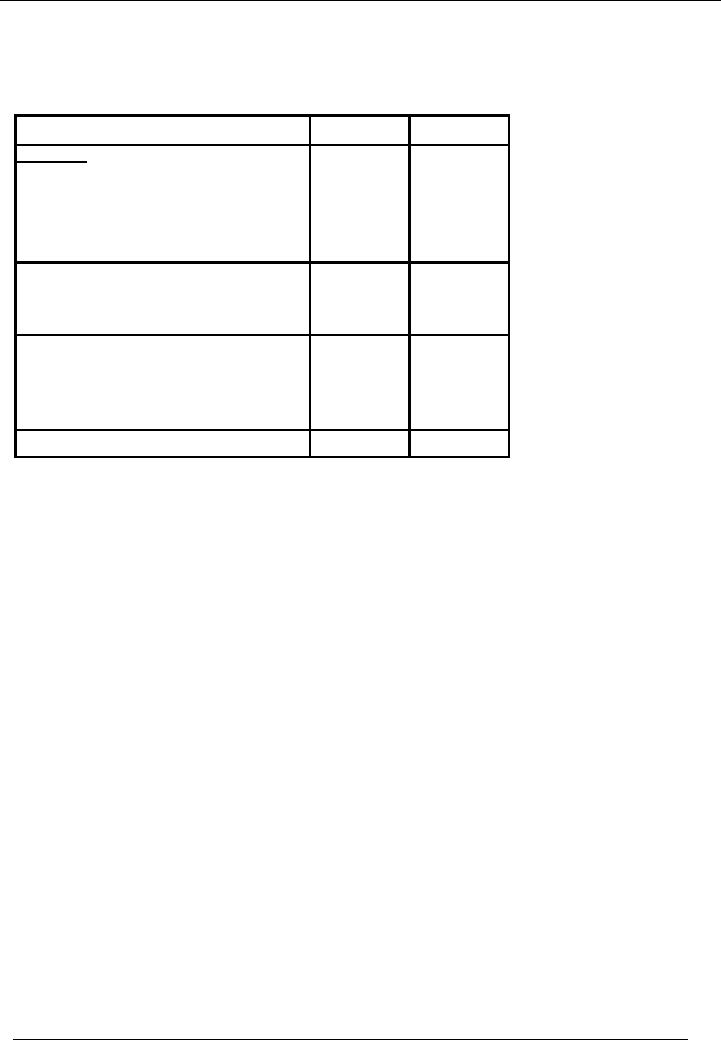 |
STANDARD FORMAT OF BALANCE SHEET |
| << STANDARD FORMAT OF PROFIT & LOSS ACCOUNT |
| DIFFERENT BUSINESS ENTITIES: Commercial, Non-commercial organizations >> |

Financial
Accounting (Mgt-101)
VU
Lesson-7
STANDARD
FORMAT OF BALANCE
SHEET
(LIABILITY
SIDE)
Particulars
Amount
Rs. Amount Rs.
Liabilities
Capital
and Reserves
Capital
X
Reserves
X
Profit
and Loss Account
X
X
Non
Current / Long Term
Liabilities
Long
term loans
X
Other
long term liabilities
X
X
Current
Liabilities
Trade
creditors and other
payables
X
Short term
borrowings
X
Current
portion of long term borrowings
X
X
Total
X
CAPITAL
Capital is the
first item shown on the liability
side of the balance sheet of an
organization. Capital is the
Money
invested in the business by the owners.
Capital is a liability for the business
as the business has to
pay
return
against this money and in
case the business is closed,
then it has to return the amount. Capital
is also
termed
as "Share Capital".
RECORDING
OF CAPITAL
Recording
of Capital is Simple
�
At the time of
receipt
Debit
Cash /
Bank
Credit
Capital
�
If the owner
contributes an asset instead of cash,
then
Debit
Asset
Account
Credit
Capital
�
When
the capital is repaid (this does not
happen in normal course of business,
but just in case)
Debit
Capital
Credit
Cash /
Bank
RESERVES
The
portion of profit which is
not paid to proprietor, but is
kept apart for meeting
some known or unknown
losses
is called Reserve, e.g.
Reserve fund, contingencies
reserve etc.
.
There
are two major types of
reserves:
�
Revenue
reserves
198

Financial
Accounting (Mgt-101)
VU
From
the view point of its
creation revenue reserve may
again be classified
into:
o
a.
General reserve
Reserve
which is not created for
any specific purpose, but
for strengthening the financial position of
the
business
is known as General Reserve, e.g.
Reserve fund, contingencies
reserve etc.
b.
Specific Reserve
Reserve
created for any special
purpose is known as Specific
Reserve. e.g., Dividend
Equalization fund,
Debenture sinking
fund etc.
Capital
Reserves
Capital
reserves, in most of the cases,
are created due to legal
requirements. Profit may
arise from sources,
other
than normal business
activity. For example,
profit on sale of fixed
assets or profit on revaluation of
fixed
assets. When a reserve is
created out of these
profits, it is termed as capital
reserve. One capital
reserve
about
which we already know is
"Fixed Assets Revaluation Reserve".
Capital reserves can be used
for
specific
purposes only.
DIFFERENCE
BETWEEN RESERVE AND
PROVISION
Both
reserves and provisions are
created out of revenues of the
business, but they differ
from each other.
� Creating
a provision is necessary to show a true
profit for the period,
whereas the reserve is
created
on the discretion
of the owner, out of profits.
� Provision
is to be made, even, if there is a
loss; Reserves are created
out of profits only.
� Reserve
is shown as liability in the balance
sheet, Provision is shown as a
reduction from the
asset
against
which it is created.
� Provision
is used specifically for the
purpose for which it is
made, Reserves are usually
general and
can be
used for any
purpose.
PROFIT
AND LOSS ACCOUNT
�
Profit
and Loss Account or Accumulated
Profit and Loss Account
shows the balance of
un-
distributed
profit accumulated over the
periods.
�
In the
first year of business, this
account shows following
figure:
Profits
for the year
X
Less:
Transferred to Reserve
(X)
Less:
Profit distributed
(X)
Balance
carried to Balance
Sheet
X
�
In
Subsequent years, balance
brought forward from previous
years and profit for the
year is added
and
distributed as above and the
balance is carried to next
year.
�
This
is why; it is termed as Accumulated Profit
and Loss Account.
199

Financial
Accounting (Mgt-101)
VU
LONG
TERM LOANS
�
The
owners of the business may feel
that their business can
flourish, if there are more
funds. These
funds
can be arranged from their
own resources, if possible, or they
can ask a bank or
financial
institution
for funds. This loan, if extended by bank
for a period of more than
one year is termed as
a long
term loan. There can be other sources of
long term loans as well, e.g. Term
Finance
Certificates
and Debentures, where money
is borrowed from general
public under certain
legal
restrictions.
OTHER
LONG TERM
LIABILITIES
These
include all other liabilities
that are payable after a
period of one year of balance
sheet date. For
example,
staff gratuity and other
benefits, taxes and
liabilities that become
payable after a period of one
year.
CURRENT
LIABILITIES
Current
Liabilities are the obligations of the
business that are payable
within twelve months of the
balance
sheet
date. Creditors, all accrued
expenses are the examples of current
liabilities of the business
because
business
is expected to pay these
back within one accounting
period.
CURRENT
PORTION OF LONG TERM
LIABILITIES
Long
term loans are usually
payable in installments. Therefore, at
every year end, some
portion of the loan
becomes
payable within one year of
the balance sheet date. The
portion that becomes payable
within the
next
accounting period is transferred to
current liabilities and classified under
current portion of long term
liabilities.
Format of current
liabilities shown in the balance
sheet is as follows:
Current
Liabilities
Trade
Creditors
Short Term
Borrowings
Other
Short Term Liabilities
Salaries
Payable
Accrued
Expenses
Bills
payable
Advances
from Customers
Current
Portion of Long Term
Liabilities
200
Table of Contents:
- Introduction to Financial Accounting
- Basic Concepts of Business: capital, profit, budget
- Cash Accounting and Accrual Accounting
- Business entity, Single and double entry book-keeping, Debit and Credit
- Rules of Debit and Credit for Assets, Liabilities, Income and Expenses
- flow of transactions, books of accounts, General Ledger balance
- Cash book and bank book, Accounting Period, Trial Balance and its limitations
- Profit & Loss account from trial balance, Receipt & Payment, Income & Expenditure and Profit & Loss account
- Assets and Liabilities, Balance Sheet from trial balance
- Sample Transactions of a Company
- Sample Accounts of a Company
- THE ACCOUNTING EQUATION
- types of vouchers, Carrying forward the balance of an account
- ILLUSTRATIONS: Ccarrying Forward of Balances
- Opening Stock, Closing Stock
- COST OF GOODS SOLD STATEMENT
- DEPRECIATION
- GROUPINGS OF FIXED ASSETS
- CAPITAL WORK IN PROGRESS 1
- CAPITAL WORK IN PROGRESS 2
- REVALUATION OF FIXED ASSETS
- Banking transactions, Bank reconciliation statements
- RECAP
- Accounting Examples with Solutions
- RECORDING OF PROVISION FOR BAD DEBTS
- SUBSIDIARY BOOKS
- A PERSON IS BOTH DEBTOR AND CREDITOR
- RECTIFICATION OF ERROR
- STANDARD FORMAT OF PROFIT & LOSS ACCOUNT
- STANDARD FORMAT OF BALANCE SHEET
- DIFFERENT BUSINESS ENTITIES: Commercial, Non-commercial organizations
- SOLE PROPRIETORSHIP
- Financial Statements Of Manufacturing Concern
- Financial Statements of Partnership firms
- INTEREST ON CAPITAL AND DRAWINGS
- DISADVANTAGES OF A PARTNERSHIP FIRM
- SHARE CAPITAL
- STATEMENT OF CHANGES IN EQUITY
- Financial Statements of Limited Companies
- Financial Statements of Limited Companies
- CASH FLOW STATEMENT 1
- CASH FLOW STATEMENT 2
- FINANCIAL STATEMENTS OF LISTED, QUOTED COMPANIES
- FINANCIAL STATEMENTS OF LISTED COMPANIES
- FINANCIAL STATEMENTS OF LISTED COMPANIES